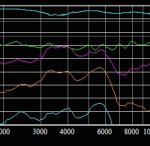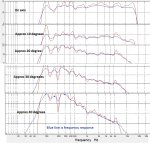Re: 60 Degree DIY Mid Hi
A lot of the people I see using Smaart don’t really understand exactly what they are measuring.
If you use an FFT with a time window that’s big enough to capture the low frequencies you are usually capturing other stuff you don’t want that mucks up your measurement.
There are basically two solutions – measure it in an anechoic chamber – or measure it a long way away from any boundary’s (12ft in the air or more) where the mic is relatively close (6 ft) to the speaker.
Note: this is a mid-Hi box operating from 100Hz up (100Hz wave length = 11.15ft, 10ms per cycle). For low frequency you can place the mic on the ground.
As a practical solution your setup with the ground sloping away looks great.
Hi & thank you Art !
Hi Peter, I've been reading about processing variations in various articles/threads, and really wonder if there is any substitute for learning to measure and know what is being measured.
I'm thinking truly learning dual FFT is what I need more than any particular processor..
That said, could you comment on how well you think the testing setup works, that i tried to elaborate on my most recent post to Don? See any issues?
I'll also post complete IIR setting being used on the 60 deg, just for double check if you have time ...
Thank ya Peter !
A lot of the people I see using Smaart don’t really understand exactly what they are measuring.
If you use an FFT with a time window that’s big enough to capture the low frequencies you are usually capturing other stuff you don’t want that mucks up your measurement.
There are basically two solutions – measure it in an anechoic chamber – or measure it a long way away from any boundary’s (12ft in the air or more) where the mic is relatively close (6 ft) to the speaker.
Note: this is a mid-Hi box operating from 100Hz up (100Hz wave length = 11.15ft, 10ms per cycle). For low frequency you can place the mic on the ground.
As a practical solution your setup with the ground sloping away looks great.





